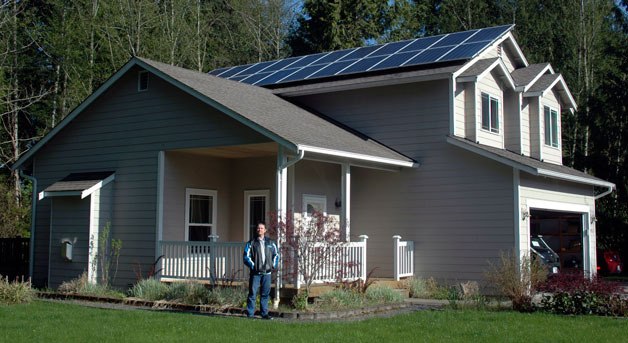ARLINGTON — Boeing engineer Tom Flandro wanted to get off the grid and wean himself from foreign oil dependency, so when he was able to convert his two-story home to solar power and purchase an electric car, he took advantage of the opportunity.
Flandro explained that the Snohomish County PUD’s “Solar Express” program offers home owners a choice between a cash incentive of up to $2,500 for pre-approved, qualified new solar panel systems, or a low-interest loan of up to $25,000 to finance the installation of the solar panel system, instead of the cash incentive.
“With everything that’s going on today, I can’t help wondering why everyone doesn’t do this,” said Flandro, who laughed as he acknowledged that the rainy Pacific Northwest might seem like a counterintuitive location for a solar-powered home. “Yes, it’s very cloudy here, but because of our latitude, the sun stays out longer during the summer months, which actually makes us more competitive than the traditional ‘sun belt’ places like New Mexico and Arizona.”
Flandro pointed out that these PUD “meter credits” from the spring and summer months can be used during the darker autumn and winter months. Northwest Wind & Solar installed the 22 SolarWorld modules with Enphase Microinverters, which are expected to generate approximately 5,000 kilowatt hours per year.
“Since the solar panels were finished being installed about a month ago, the electrical bill for my house has gone from $100 a month to literally nothing,” Flandro said. “Since I bought my Nissan Leaf three weeks ago, I’ve already saved about $200 in gas money, what with gas shooting up to $4 a gallon. My Mustang gets 22 miles to the gallon, and I’d easily drain that tank within a week.”
Flandro recharges the Leaf with a charger that he received government funding to install in his garage. He explained that each charge will last about 100 miles, and a completely drained battery can be recharged to 100 percent within seven hours, so he just plugs his car into the charger once he comes home. Although the current distribution of recharging stations have seen him mostly driving his Leaf to work and back home, he noted that Seattle has a number of such stations, “and more are popping up every day.”
“It’s been a dream of mine to do this for a long time,” he added.








